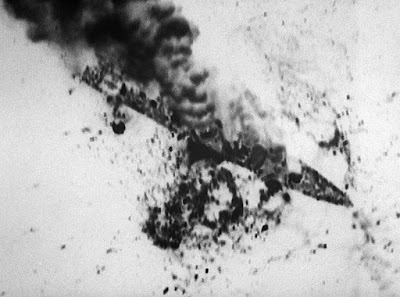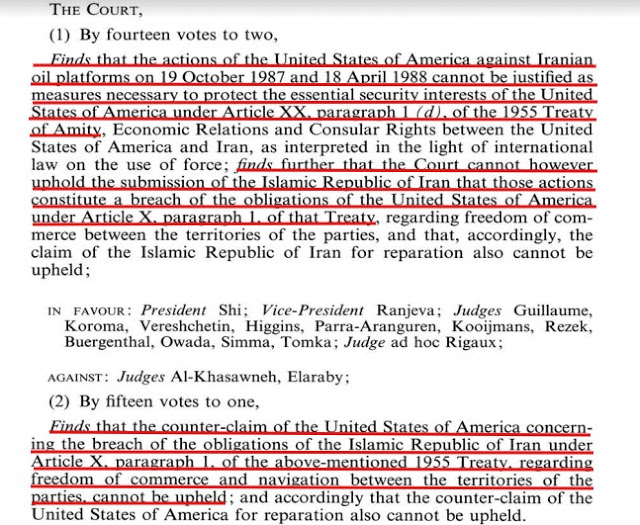
By Daled Amos
Over a week has passed since the US operation that took out Qasem Soleimani, and during that time the media — both social and mainstream — has featured opinions, both pro and con, as to how to interpret what happened.
Those who think Trump deserves a medal, or at least another 4 years in office, see the operation as a major success in the fight against terrorism in general and against Iran in particular.
The Daily Caller proclaimed that Trump Eliminates Some Of World’s Top Terrorists In Just A Few Months. It includes in that list:
o Hamza bin Laden, the son of Osama, who had been taking a more prominent role in al-Qaeda, but may have been killed any time in the last 2 years
o Abu Bakr al-Baghdadi, the leader of ISIS
o Abu Hassan al-Muhajir, the likely successor to al-Baghdadi
o Abu Mahdi al-Muhandis, the leader of Kataeb Hezbollah or the Popular Mobilization Forces, which was responsible for the attack that killed an American contractor, leading to the storming of the US embassy and the US operation that took out both Soleimani and al-Muhandis in the same strike.
On the other hand, in a radio interview, Daniel Pipes was critical of any benefit from killing Soleimani and of Trump’s Middle East policy in general. Pipes didn’t think killing Soleimani was all that important:
I’m inclined to think it’s a less important event than most people. In the first place, Soleimani was an operative, not a decision-maker; he carried out instructions, he didn’t develop those instructions. He was clearly very competent at it, but operators are not that difficult to find. And there have been prior cases where an operator has been taken out, and then someone else replaces him and is about as good, or maybe even better. So, I don’t think the killing has enormous consequences for Iranian capabilities.…It makes sense strategically if it’s followed up. If it’s a one-time thing, it doesn’t make much difference. But if it is followed up, this means that after 40 years of the Islamic Republic of Iran, the U.S. government has finally decided to respond to its aggression not just economically, but militarily: to Iran’s building nuclear weapons, to its jihad, to its more or less taking over four countries – Yemen, Lebanon, Syria, and Iraq – and to its ideological aggression. If this means a such a profound change, then yes, it’s big. But if it’s a one-time killing of an operative, no, it’s not very significant.
But let’s evaluate Trump’s decision to kill Soleimani in the context of past presidents and the measures they took — or didn’t take — in response to terrorist attacks against US citizens.
In September 2004, Norman Podhoretz, form editor-in-chief of Commentary Magazine, wrote World War IV: How It Started, What It Means, and Why We Have to Win. In comparison with World War I and World War II, Podhoretz sees the Cold War as World War III and the threat subsequent to 9/11 as World War IV.
He writes that starting with Richard Nixon back in 1970 and continuing with Gerald Ford, Jimmy Carter, Ronald Reagan, George H.W. Bush, Bill Clinton, and up to “the pre-9/11 George W. Bush” — US did not respond to terrorist attacks. For example, during both the Nixon and Ford administrations, from 1970 to 1975, several US diplomats were murdered in Sudan and Lebanon and others were kidnapped, all by factions of the PLO.
And there were no reprisals.
We know what happened to US citizens in Iran in 1979 during the Carter administration.
We also know that just hours after Reagan became president in 1981, Iran released the hostages, apparently out of fear of what the hawkish Republican president might do.
But neither Iran’s supposed fear nor Reagan’s hawkishness lasted for long, according to Podhoretz’s list of US appeasement under Reagan, where there was no retaliation for terrorist attacks:
o In April 1983, Hezbollah exploded a truck in front of the American embassy in Beirut, Lebanon –killing 63 employees, including the Middle East CIA director. 120 were wounded.o In October 1983, a Hezbollah suicide bomber blew up an American barracks in the Beirut airport, killing 241 U.S. Marines in their sleep and wounding another 81. This time, Reagan approved plans for retaliation, but Secretary of Defense Caspar Weinberger convinced him to cancel it because it might damage US relations with the Arab world. Soon after, Reagan pulled the Marines out of Lebanon.
o In December of that year, the American embassy in Kuwait was bombed.
o In March 1984, the CIA station chief in Lebanon, William Buckley, was kidnapped by Hizbullah and then murdered.
o Buckley was the fourth American to be kidnapped in Beirut, and many more suffered the same fate between 1982 and 1992 (though not all died or were killed in captivity).
o In September 1984, the U.S. embassy annex near Beirut was hit by yet another truck bomb, also traced to Hezbollah. In this case, Reagan did approve covert proxy retaliations by Lebanese intelligence agents, but then pulled the plug when one operation failed to get its main target and unintentionally killed 80 other people.
o In December 1984, a Kuwaiti airliner was hijacked and two American passengers employed by the U.S. Agency for International Development were murdered.
o In June 1985, Hezbollah operatives hijacked still another airliner, TWA flight 847. An American naval officer aboard the plane was shot, and his body was hurled onto the tarmac.
o In October 1985, an Italian cruise ship, the Achille Lauro, was hijacked by a group under the leadership of the PLO’s Abu Abbas, with the support of Libya. An elderly wheelchair-bound American passenger, Leon Klinghoffer, was thrown overboard. Klinghoffer’s murderer was apprehended and sent to prison in Italy, but the Italian authorities let Abu Abbas go. The US protested the release of Abu Abbas, but Italy let him go anyway.
o In December 1985, Rome and Vienna airports were bombed and 20 people were killed, including 5 Americans. In April 1986 a discotheque in West Berlin frequented by American servicemen was bombed. In this case, when US intelligence tied Libya to both bombings, an American air attack in retaliation hit one of Qaddafi’s residences — and in retaliation, Palestinian terrorist Abu Nidal executed 3 US citizens who worked at the American University in Beirut.
Not exactly the kind of record we would have expected of Reagan, whose promise to restore US pride was one of the reasons for his landslide victory over Carter.
But Podhoretz leaves something out of his list.
In Qassem Soleimani Is Dead: What You Need To Know And What Happens Next, Michael Rubin briefly mentions action that Reagan took against Iran towards the end of his term in office:
In 1987, President Reagan ordered the reflagging of Kuwaiti tankers. Shortly after, the SS Bridgeton, a reflagged tanker, struck an Iranian mine. Mir-Hossein Mousavi, today considered a reformist leader, commented it was “an irreparable blow on America’s political and military prestige.” Iranian blustered increased until, the following year, President Ronald Reagan ordered Operating Praying Mantis after the Samuel B. Roberts struck a mine. That skirmish escalated into one of the largest surface naval engagements since World War II and led to the decimation of the Iranian Navy and Air Force. Iranian leaders blustered then as now, but refrained from attacking the United States directly for years after until the generation of military officials who experienced that day slowly rose through the rank and retired.
 |
| An aerial view of the Iranian frigate IS Sahand burning on 18 April 1988 after being attacked by aircraft of U.S. Navy. Public Domain |
The Washington Post at the time reported US Sinks or Cripples 6 Iranian Ships in Gulf Battles, describing it as “the sharpest hostilities between the United States and Iran since the fall of the shah in 1979”:
The United States sank or crippled six Iranian ships and fired at Iranian warplanes yesterday during a daylong series of fierce sea and air battles that erupted across the Persian Gulf after the U.S. Navy destroyed two oil platforms in a retaliatory strike ordered by President Reagan.…U.S. estimates of Iranian ship losses as of last night were one Combattante II high-speed missile boat sunk; one Boghammar patrol boat sunk and two others believed crippled, and two Vosper Mark 5 frigates severely damaged, if not sunk.
President Reagan said, “We aim to deter further Iranian aggression, not provoke it. They must know that we will protect our ships, and if they threaten us, they’ll pay a price.” There was wide bipartisan approval in Congress of the president’s action. [emphasis added]
The US operation was initially only against the 2 Iranian oil platforms — a tactic that it had carried out the previously year, in response to a missile attack on a US-flagged oil tanker.
And the fight between the US and Iran did not end there.
Both sides appeared before the International Court of Justice, where both the US and Iran argued that the other was in violation of the 1955 Treaty of Amity between the 2 countries.
For all the strength embodied in these 2 measures during the last years of the Reagan administration, they are still not typical of the US response to Iran, let alone to terrorist attacks against Americans.
Taking out ships and oil platforms is not the same as taking out terrorists that murder your citizens. Then again, today, Iran’s ambitions in the Middle East — and beyond — has grown in proportion to its growing number of proxies.
And this has happened, unchecked by the West.
To that extent, Lee Smith echoes Podhoretz, when he writes that Iran and America Are Suddenly Both Naked:
Iranian-backed terror isn’t a stubborn, unchanging fact of the international landscape, except to the degree that we made it so. The policy of appeasement that began in 1979, with the embassy takeover, culminated in the 2015 Joint Comprehensive Plan of Action (JCPOA) when the Obama administration flooded Soleimani’s war chests with hundreds of billions of dollars and legitimized Iran’s “right” to a large-scale nuclear weapons program. In line with the decadeslong U.S. policy of augmenting the Iranian threat in order to avoid taking action against it, Obama said the only alternative to giving Iran the bomb was war.
And to the extent that he broke the rules whether in moving the US embassy in Israel to Jerusalem or recognizing the legality of Israeli settlements — Trump is the bull in the china shop that is the Middle East when it comes to Iran:
It was perhaps to be expected that an outsider who often doesn’t know when to keep quiet, and can’t stay off Twitter, would be the one to sing out like the boy in the fairy tale. It’s true, the emperor has no clothes.
Like Reagan, Trump too has seemed been reluctant to get too heavily entangled in Middle East power struggles. But now that he has actually drawn that red line, will he, like Reagan, be willing — and able — to maintain it?
We have lots of ideas, but we need more resources to be even more effective. Please donate today to help get the message out and to help defend Israel.


Leave a Reply